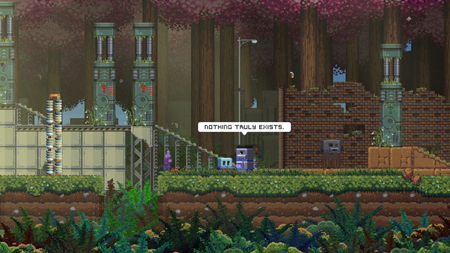Robot plane shifting platforming fun. For the most part.
It was back at EGX 2014 that I first got some hands on time with Poncho, and enjoyed it’s 16-bit style platform shifting aesthetic, although I was a little frustrated by the difficulty of some of the puzzles. Since then, the game had a Kickstarter campaign that didn’t fund, but it managed to find a publisher and now it’s arrived.
Poncho is a puzzle platformer by Delve Interactive. The game sees you control a poncho wearing robot. The world has ended and your mission is to discover what happened and find your father. The idea of each level is to get to the teleporter at the end, collecting as many keys and collectables as possible to aid your progress. The levels are essentially cylindrical, so once you go all the way to the right, you’ll find yourself back on the far left where you started again. The game hinges around a plane shift mechanic, where each level is made of up several planes, and the idea is you hit the shoulder buttons to change between them and reach different areas.
There are various keys around the levels you can collect, which can unlock short cuts and different paths. As well as the keys, you collect red pieces in each level which act as a currency in order to buy extra keys from various trenchcoat wearing robots. You can also earn extra keys by finding various broken robots around the world and returning them to the junkyard for the King of the Junkyard.
The plane shifting is the game’s primary mechanic, and there is no combat. Later levels throw new puzzles at you, such as platforms that also periodically shift planes, or shift planes according to how many times you yourself shift. There are also switches you hit in order to move parts of another plane around in order to allow you to reach other areas. There is a great joy to be had as you jump off a platform and switch to a small box in the layer behind, to then jump up to the layer behind that and continue your journey.
There are however frustrations with some of these puzzles. The platforms that shift according to how many times you shift can cause you to have to shift around several times to get them in the position you want, which is kind of irritating. Especially when you try and fail a jump and have to shift around again to get them back in position. The levels where you have to move vertically are where all the shifting platforms become a pain, and one wrong move can send you right back to the beginning, which feels horribly unfair at times. There are also problems with objects in the foreground getting in the way when you’re trying to find your way behind them, leading you to falling down holes you couldn’t see.
Another problem with the game involves a level where you’re underwater in some sections, and have to hold down a button to see the depths of where the platforms actually are in relation to one another. I get trying to perhaps do something different with a different environment, but having to constantly check to see where you need to land led to many annoying deaths. On the subject of deaths, dying in certain places could send you into a death loop where you respawn above where you died, so you could fall into a hole several times. Although the developers have been updating the game since release and this doesn’t seem to be as much of a problem now.
The game is all wrapped up in a retro style 16-bit aesthetic, with charming looking characters pondering life and their existences. There aren’t a lot of them, though, as you might expect for a game set in a post apocalyptic world. Bugs fly around in the foreground and background, and you can see interesting looking buildings in the background that might seem unreachable until you get further along. The soundtrack is excellent and really fits the game’s theme and charm as well, and the noises and speech that some of the characters help to give them some character.
FINAL THOUGHTS
Poncho is a solid, charming and fun platformer for the most part. The environments and characters are interesting It’s challenging, however in quite a few cases the challenge doesn’t always feel fair. The shifting aspect is an interesting and unique mechanic that makes this interesting. However, there are problems with the longer sections, where trying to figure out what you’re supposed to be doing in the middle of actually doing it gets frustrating, and the vertical sections are difficult to the point of unfairness. But if you can deal with those problems, then there’s an enjoyable experience to be had here.
 BrutalGamer Bringing you Brutally Honest feedback from today's entertainment industry.
BrutalGamer Bringing you Brutally Honest feedback from today's entertainment industry.








